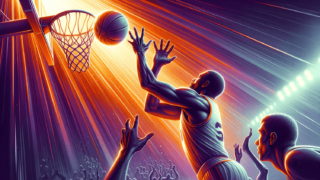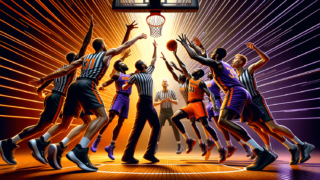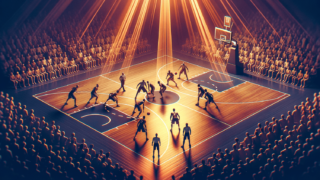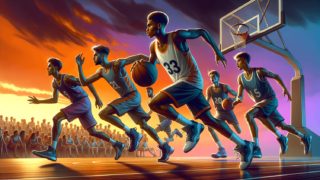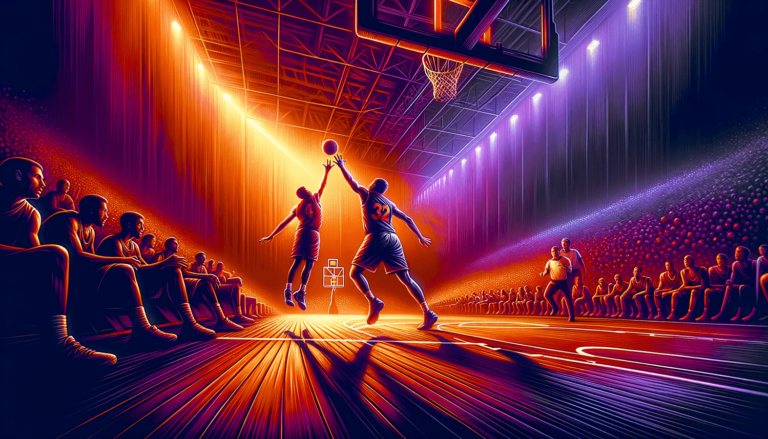
Six-Foul Limit in Basketball
Written by: Basketball Universe
Last updated:

Ever watched basketball and wondered why players become extra cautious after catching a few fouls? Today, we’ll dive into the fascinating world of the six-foul limit, a rule that shapes the game’s strategic landscape and gives it the intensity we all love. Whether you’re a passionate fan or new to the sport, grab your virtual popcorn, take a seat, and get ready for a slam dunk analysis of this intriguing rule that keeps players, coaches, and fans on the edge of their seats.
Six-Foul Limit in Basketball
The six-foul limit in basketball is a rule that restricts the number of personal fouls a player can commit during a game. Once a player accumulates six fouls, they are disqualified from the match, with no ability to return. This rule encourages more strategic gameplay, as players and coaches must manage each player’s fouls to avoid losing key contributors in crucial moments.
Understanding Personal Fouls in Basketball
Before we get into the six-foul limit, it’s crucial to understand personal fouls in basketball. A personal foul occurs when a player makes illegal contact with an opponent while the ball is live, affecting that opponent’s movement or shooting ability. Common examples of personal fouls include charging, blocking, hand-checking, and reaching. Typically, a player committing a personal foul results in a whistle by referees, stopping play and potentially awarding free throws to the fouled player or possession of the ball to the affected team.
The Evolution of the Six-Foul Limit
Historically, the six-foul limit wasn’t always the standard in basketball. In the early days, players could commit up to seven fouls in a game before being disqualified. As basketball evolved, the rules changed, and by the mid-1940s, most leagues, including the NBA, had adopted the six-foul limit. This adjustment was made to encourage better player behavior and to create a more viewer-friendly competition with fewer interruptions.
The FIBA and NCAA Difference
While the NBA follows the six-foul limit, other governing bodies have slightly different rules. In FIBA, the international governing body of basketball, players are disqualified following their fifth personal foul. The NCAA, which governs college basketball in America, also disqualifies players after five personal fouls. These differing rules emphasize the importance of understanding the governing rules for each league and adjusting strategies accordingly.
Impact of the Six-Foul Limit on Gameplay
The six-foul limit has a significant influence on the game in numerous ways, shaping how coaches and players strategize during a match. The limit impacts player rotations, substitution patterns, defensive tactics, and individual player styles.
Managing Player Rotations
Successful teams often have deep benches with talented players ready to contribute when needed. Coaches must consider each player’s foul count when making decisions about substitution patterns. If a player picks up early fouls, a coach may decide to rest that player to conserve their fouls for later in the game. Conversely, if a player isn’t in foul trouble, a coach could extend their minutes on the court, trusting they won’t be in danger of disqualification.
Defensive Adjustments
To avoid fouling out and save fouls for more critical defensive plays, players must manage their defensive aggressiveness. For example, if a player only has one foul left, they might avoid risky shot-blocking attempts or switch defensive assignments to avoid fouling out on a key player. Similarly, coaches can adapt by implementing zone defenses, to diffuse responsibility and limit direct contact, reducing the likelihood of players accumulating fouls.
Adapting Player Styles
Individual players must balance aggression and smart play, especially on the defensive end, to avoid accumulating fouls. Learning to play disciplined defense and understanding when to contest shots or position themselves for charges without fouling is essential in maximizing each player’s impact within the six-foul limit. Players also can use the rules strategically on offense by targeting opponents in foul trouble, trying to draw fouls and force them to the bench.
How the Six-Foul Limit Affects Star Players
Star players are often relied upon to make key plays, grab rebounds, and score points, but their contributions can be limited if they pick up early fouls. Implementing strategies to minimize foul trouble for top players is crucial for maximizing their impact within basketball rules.
Altering Offensive Strategy
If a star player is in foul trouble, the team may run plays designed to limit the player’s defensive exposure. For example, instead of using a pick-and-roll where the star player sets the screen, they may position themselves farther from the action, to reduce the risk of committing an offensive foul.
Mindful Substitutions
During critical moments, coaches may choose to risk playing a star with foul trouble, understanding the game’s outcome may depend on their involvement. Coaches must weigh the player’s importance against the risk of them fouling out, and strategize accordingly.
Learning the Art of Drawing Fouls
Another aspect of the six-foul limit is the skill of drawing fouls in basketball. Many players are adept at forcing opponents to commit fouls, potentially affecting the opposition’s key players and game strategy. Analyzing how these players operate is a valuable lesson in exploiting the six-foul limit.
Mastering the Pump Fake
One of the most common ways to draw fouls is utilizing the pump fake. Skilled players use this deceptive move to fool defenders into leaving their feet, hoping for a block. Once airborne, the offensive player can make contact, typically resulting in a shooting foul and a trip to the free-throw line.
Driving the Lane
Agile players that excel at driving the lane often force defenders into committing fouls. By attacking the rim aggressively, players may expose their opponents’ slow footwork, causing blocking fouls. Teams with penetrating guards often instigate foul trouble for the opposition, reshaping defensive strategies and lineups.
Manipulating the Six-Foul Limit
Understanding basketball rules, especially the six-foul limit, allows coaches and players to manipulate the game to their advantage. By targeting opposing players with foul trouble, managing rotations, and exploiting areas where fouls are likely, a team can significantly impact their chances of victory.
Foul Trouble for Opponents
Once an opposing player has accumulated several fouls, you can target this weakness. Direct offensive plays against the player in foul trouble can force them to either play less aggressively, potentially offering scoring opportunities or risk disqualification by committing additional fouls.
Hack-a-Player Strategy
Sometimes, coaches will employ a controversial tactic known as the “Hack-a-Player” strategy, intentionally fouling a poor free-throw shooter to force them to the line. Though this plan doesn’t focus on the six-foul limit directly, it highlights the strategic use of fouls to manipulate the game in a team’s favor.
Conclusion
The six-foul limit is a critical aspect of basketball, influencing gameplay, coaching decisions, and player development. Mastering the intricacies of this rule, adjusting strategies, and exploiting the opposition’s weaknesses can make the difference between victory and defeat. As fans, understanding the significance and impact of the six-foul limit deepens our appreciation for the sport and the chess match played between coaches and players on the hardwood.
Historic Moments Driven by the Six-Foul Limit
There have been instances in basketball history where the six-foul limit significantly influenced the game’s outcome. Examining these events helps us understand the foul limit’s importance and the fascinating situations it can create in basketball.
Going Beyond Six: Shaquille O’Neal’s Infamous Game
In a 2000 game between the Orlando Magic and the Indiana Pacers, NBA legend Shaquille O’Neal accomplished the rare feat of playing beyond the six-foul limit. Due to a miscommunication between the scorekeeper and the referees, O’Neal was allowed to continue playing after picking up his sixth foul. This incident underscored the need for maintaining strict adherence to the rules and the importance of adequate communication among officials.
Rare Double-Foul Call to Save a Player
On occasion, referees may call a double-foul involving two players, with offsetting penalties that effectively cancel each other out. This rare circumstance provides another example of how the six-foul limit can create dynamic scenarios on the court. In such cases, creative coaching and strategic thinking can lead to unique attempts to negate the foul limit’s impact and preserve key players.
The Impact on the Fan Experience
The six-foul limit in basketball also delivers unique suspense and excitement for fans. As their favorite players approach the foul limit, fans are often left wondering if they’ll be disqualified or saved by their team’s strategy. These dramatic situations can enhance the sense of urgency and excitement that makes basketball such a captivating sport for fans worldwide.
Cheering for Your Team and the Foul Count
As a fan, keeping track of opposing players’ foul counts can add another dimension of engagement to the viewing experience. When a star player on the opposing team accumulates fouls, fans often become more animated, cheering louder for their team, hoping to see the opposition’s key player sidelined. This fan engagement highlights the six-foul limit’s role in creating high-stakes drama and entertainment value in basketball.
Preventing Foul Trouble: Training and Preparation
To make the most of the six-foul limit, players and coaches must invest time and effort into developing techniques and training plans that minimize foul trouble. By refining player discipline and awareness, they can enhance their team’s competitive advantage.
Defensive Drills
By incorporating defensive drills that focus on avoiding contact and maintaining proper positioning, teams can reduce the risk of foul trouble. These drills can include exercises that emphasize sliding feet to stay in front of offensive players and maintaining adequate distance during shot contests. By consistently rehearsing these defensive principles, players can minimize their propensity for fouling and increase their on-court effectiveness.
Film Study and Scouting
Another key aspect of avoiding fouls is understanding the opposition’s offensive tendencies. Film study and scouting allow players to gain insights into potential opponents, allowing them to anticipate offensive moves more effectively and avoid committing avoidable fouls. By leveraging this knowledge and applying tactics focused on a specific opponent, players can stay on the court longer and contribute more substantially to their team’s success.
Frequently Asked Questions
As we delve into the realm of the six-foul limit and its impact on the game of basketball, you may have some pertinent questions about the topic. In this section, we address ten common questions with concise answers to help you expand your understanding of this essential rule.
1. What is the penalty for reaching the six-foul limit?
When a basketball player reaches the six-foul limit, they are disqualified and cannot participate for the remainder of the game. Their team must substitute them with another player from the bench.
2. Does the six-foul limit apply to technical fouls?
Yes, the six-foul limit in basketball includes both personal and technical fouls. When a player accumulates a total of six fouls—personal, technical, or a combination—they are disqualified from the game.
3. How does the six-foul limit affect team fouls?
While the six-foul limit directly affects individual players, it also impacts the total team fouls. When a team accumulates a certain number of fouls in a period – in the NBA, it’s five – the opposition receives bonus free throws for every subsequent foul for the remainder of that period.
4. What happens if all players on a team reach the six-foul limit?
In the highly unlikely event that all players on a team reach the six-foul limit, the last player to foul out remains in the game. However, a technical foul and two free throws are awarded to the opposing team for every additional personal foul committed by this player.
5. Does the six-foul limit reset at the end of regulation in the case of an overtime game?
No, the six-foul limit does not reset upon entering overtime. Players must continue with their current foul count from regulation time, which may result in fouling out and disqualification during the overtime period.
6. Can a team avoid fouling out a player by only committing team fouls?
No, team fouls are the sum of individual players’ fouls. When a player commits a personal foul, it contributes to both their personal foul count and the team’s total fouls.
7. Can a player be disqualified with less than six fouls?
Yes, a player can be disqualified with less than six fouls if they receive two technical fouls or one flagrant 2 foul. Technical fouls are assessed for unsportsmanlike or prohibited behavior, and flagrant 2 fouls are given for severe or extreme acts of aggression.
8. How do foul limits differ in leagues other than the NBA?
While the NBA adheres to the six-foul limit, other leagues, such as FIBA and the NCAA, have different foul limits. In both FIBA and NCAA games, a player is disqualified after accumulating five personal fouls.
9. Has the six-foul limit ever changed?
Yes, the six-foul limit has evolved over time. In the early days of basketball, players were allowed up to seven fouls before being disqualified. The six-foul limit was introduced in the mid-1940s to encourage better player behavior and reduce disruptions during games.
10. How do fouls affect player statistics?
Fouls are a statistical category tracked and recorded during basketball games. While accumulating fouls typically does not directly impact a player’s performance metrics, such as points, rebounds, or assists, it can indirectly affect these statistics by limiting their minutes on the court due to foul trouble, disqualification, or playing less aggressively to avoid fouling out.
Featured Posts
- No pillar pages found.

